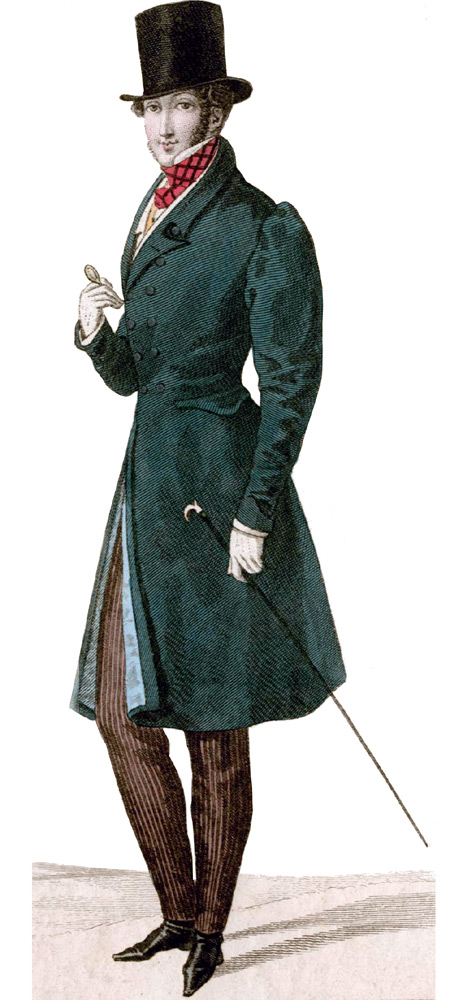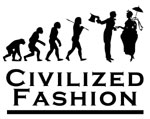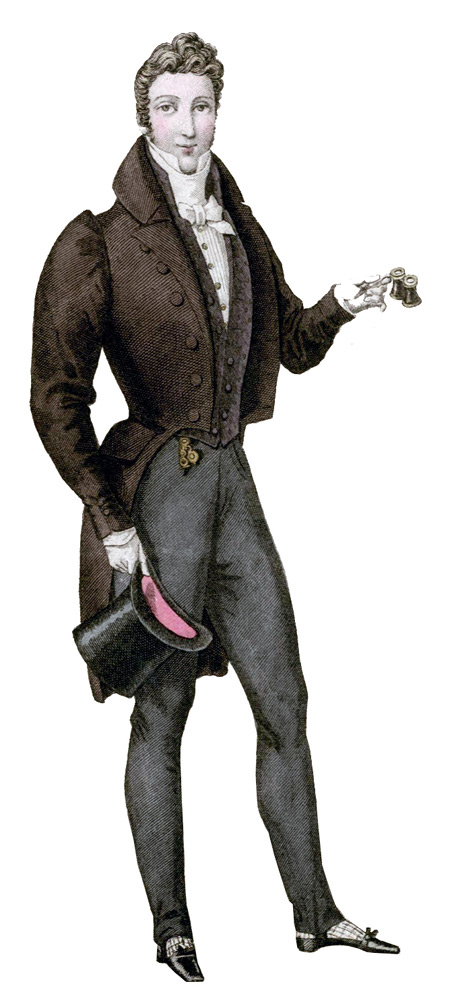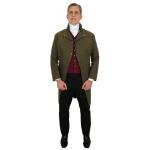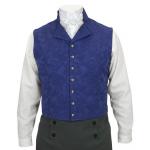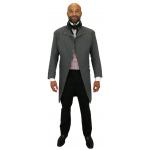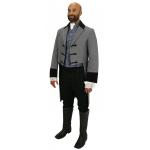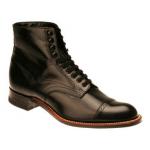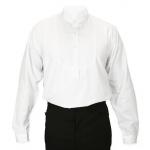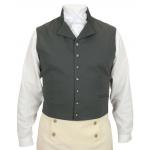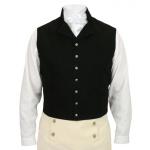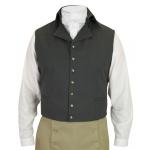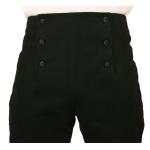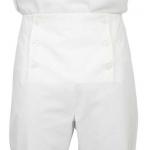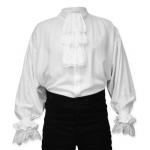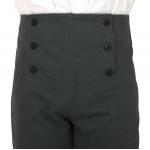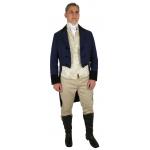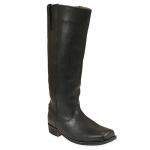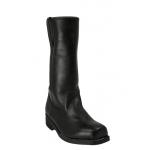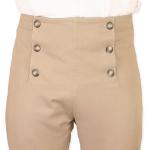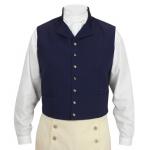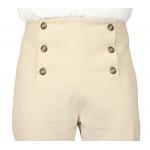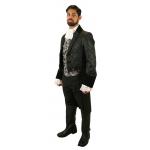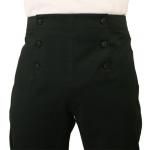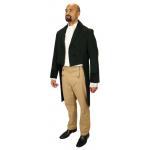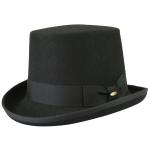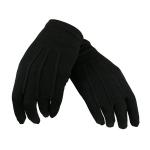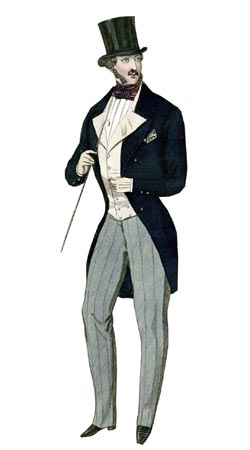Prices and Availability Subject to Change. Please call 800-997-4311 for more Information.
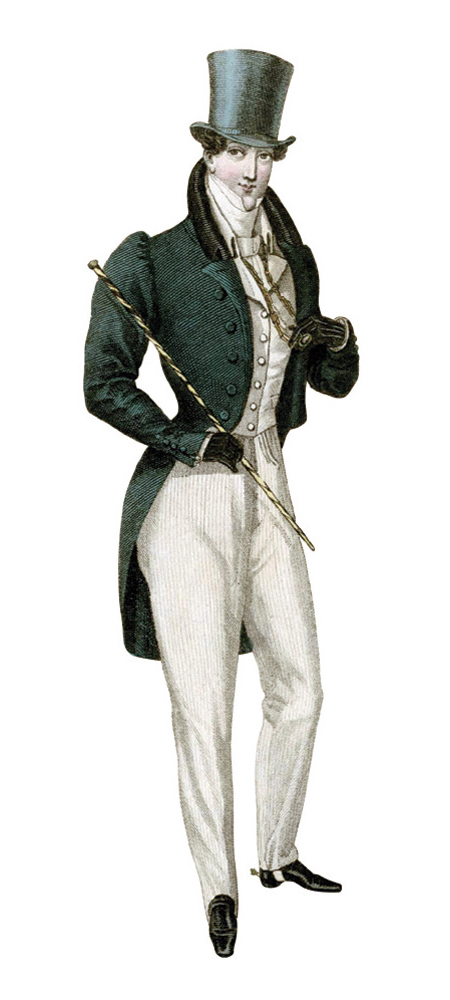
Regency Mens Clothing (1800s - 1830s)
As fashion promenaded into the Regency era, men's style stepped away from the once-popular look of a powdered-wig peacock and toward that of a notably understated yet impeccably dressed dandy. Gone were flamboyant vests, coats and pantaloons cut from stiff silks in vivid colors adorned with elaborate embroidery. In France, limited availability of fine textiles during the French Revolution, along with the fear of looking aristocratic enough to be delivered to the guillotine, were partially behind this swing toward a more sedate color palette. Later on, the uniforms of Napoleonic soldiers (1803-1815) also had a great impact on men's style, with pantaloons tucked into military style Hessian or Wellington boots, and braid and frogging became all the rage.
However, the turn of the 19th century marked the era of the English tailor, praised for their skill with woolen suiting and impeccable attention to fit. Society figures like Beau Brummel, celebrated for his flawlessly executed style, popularized this new look, and English country style, popular in certain circles since the 1780s, became mainstream fashion for menswear in both England and France. This shift in men's fashion marked the first separation between menswear and womenswear in terms of decoration and fabrics, and set the mold for how we think of menswear today.
Learn More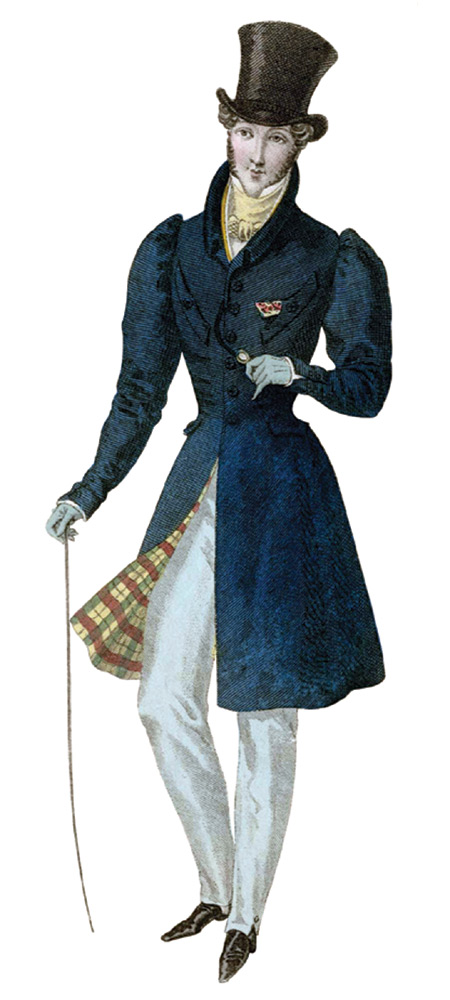
Complete Regency Outfits
We offer a full line of men's period clothing which are suitable for movie and TV production, theatrical, living history and performing arts requirements, and are also perfect for vintage weddings!
All of the products we sell are sold individually, but we have put together these full outfits to showcase the elements of Regency style for your consideration and inspiration.
Click any image for a close-up and a list of the products shown.
Mens Regency Collection
Elements of Regency Style
Although men's fashion in the early 1800s was less conspicuous in construction and color, it was in no way unkempt or worn without discernment. The three basic elements were the coat, the waistcoat, and breeches or pantaloons. It was rare for all three pieces to be the same color. Setting the era's high standards for dressing and deportment was Beau Brummel, an English dandy, friend of royals and high society hob-nobber.
This arbiter of fashion brought focus to the quality of fabric and accuracy of the cut over the lavishness of the embroidery and color. This influence continues today in the staid blues, browns and blacks of most men's suits. Fastidious and with the finest of tastes, Brummel was known to spend extraordinary amounts of time and money on his wardrobe - some say he even polished his boots with champagne!
Regency Coats - The fashionable coats of this era reflected the continued fascination with English country style. With the front part of the coat removed at the waistline, tailcoats allowed gentlemen to ride more easily, and by 1800 the tailcoat had become the coat of choice for all formal occasions, both day and evening. The tailcoats were typically tailored in a fine quality, felted wool, in a dark color - blue, brown, black, claret or green. The cut-away portion could be straight across, or cut in an inverted U-shape. They could be single or double breasted, with a tall collar, which became very tall, stiff and rounded as the silhouette changed into the 1820s.
A less formal option was the riding coat or "Newmarket" - a single breasted style of tailcoat which sloped gently to the hem, rather than being cut away squarely at the waist. This style would gain greater favor in the middle and end of the nineteenth century as the cutaway (or morning) coat.
The Redingote - a French adoption of the name "riding coat" but not to be confused with the former - became popular in the 1820s, its full flared skirts cut to the knee emphasized the new fashion for a tight waistline. Single or double breasted, this coat originally featured military braid froggings and a tall stand collar, but later came to have the same collar and lapels as the tailcoat, and was the precursor to that staple of Victorian menswear, the frock coat.
Later, Regency coats of all types featured sleeves which puffed generously at the shoulder, and tight waistlines which necessitated the addition of a waist seam to the coat, a feature of menswear for the next several decades. Some dandies went so far as to cinch their waists with corsets and pad their coat's shoulders to achieve the more desirable look.
Regency Waistcoat or Vest - Regency waistcoats were cut short and straight across at the natural waist, with a slim fit and high stand collars, all the better to accent the elaborate cravats. Either single or double breasted, and never made in the same color as the coat, waistcoats were a chance to showcase more colorful fine fabrics and embroidery. Often the tailcoat worn over the waistcoat was cut even shorter so that the fine fabrics would peek from the bottom, and by the end of the 1820s the coats would barely close over the chest, showing the whole waistcoat to great effect. These later waistcoats emphasized the new Romantic silhouette of puffed out chests and nipped in waists with points at the center front hem, and the new, lower, shawl collar, and it was not uncommon for two or more waistcoats to be worn at the same time.
Regency Pants - In the few decades of the Recency, we see the complete transition from breeches, which had been standard menswear unchanged for the previous century, through pantaloons, to trousers almost as we know them today.
Breeches were still worn for day and evening into the 1800s, cut just below the knee and fastened with buttons or buckles and ties but were increasingly slim fitting.
More fashionable in this period however were pantaloons, extending to the calf, then later the ankle and held in place with a strap under the instep. Both breeches and pantaloons were often made of fine wool cut on the bias so as to be very fitted, almost like tights. Tucking breeches or pantaloons into tall military-style boots was the height of fashion in the 1800s and 1810s. Light colors were in vogue, with cream being considered the proper choice for evening, paired with a dark blue or black tailcoat, and light colored waistcoat.
By the 1820s, breeches were rarely worn in the day except for riding, or other sports, and the tight fitting pantaloons were being increasingly replaced by slim trousers, either cut straight over the hips, or full and pleated into the waistband in the Cossack style, both secured by an instep strap to maintain an elegant line. For evening, pantaloons in cream or black were the fashionable choice for evening wear until well into the 1830s.
Rather than the single opening of modern day, all Regency pants had a flap panel 5-8 inches wide called a fall that opened in the front and fastened with buttons. The single button fly was increasingly seen on trousers through the 1830s, and became standard issue by 1840.
Regency Mens Shirts - Shirts, almost exclusively white, featured starched chin-high collars throughout this period, to accommodate an array of elaborate cravats and stocks. Partial front plackets buttoned half way down and were frequently festooned with ruffles, and later, tucks or pleats. The 1820s brought about the separate collar, which could be removed and washed apart from the shirt.
Elaborate Regency Tie/Cravat - Regency men wore a cravat; a large square of starched muslin or silk which was folded diagonally and carefully folded into a variety of styles. The color and knot of a cravat were the cornerstone in a gentleman's ensemble, speaking to both his rank and valet's skill, with whole guides written on the subject. Colors were considered very casual, patterned white could be worn for half-dress, but always plain white for evening wear. It is rumored that the meticulous Beau Brummel was so particular about this punctuating accessory that he would often tie 20 cravats before he was satisfied.
Stocks, originating in military costume, were an alternative to a cravat in the 1820s, having been made fashionable by the new king George IV. A shaped band of horsehair, buckram or whalebone bound with leather, and fastened at the back with ties or a buckle, they were covered in fabric, sometimes plain, sometimes with a bow tied on top. The 'Royal George' was a black silk velvet stock, and black silk stocks continued to be worn into the 1840s.
Regency Top Hats - Rather than the tricorn hats of yesteryear, from the turn of the 19th century the true gentleman wore a top hat made from wool felt or beaver pelt, and later on silk. In the Regency era, top hats were seen in a variety of shapes and colors. The bicorne of the 18th century remained fashionable for evening wear, some were designed to collapse to be tucked under the arm and were called chapeau-bras.
Regency Footwear - The high-heeled, big-buckled and often jewel-bedecked shoes of the 18th century gave way to leather laced shoes and knee-length boots, while heels were relegated to full court dress only. The flashy uniforms of the Napoleonic Wars (1803-1815) inspired a military theme in civilian clothing too, with breeches and pantaloons tucked into either a Hessian boot, which were knee height and often featured a decorative tassel, or the square-toed and lower-cut Wellington, named for the British duke and general. Wellingtons continued to be worn into the 1840s as they could be worn underneath the newly fashionable trousers.
For evening, black leather dress pumps were worn, fastened with ribbons tied into neat bows.
Regency hairstyles and accessories
Elaborate powdered hairstyles were left in the previous century, as Regency men began to cut their hair short and leave it natural. Classically inspired, like much of the fashion of the time these hairstyles had names like a la Titus or Brutus. A gentleman would also wear a watch, tucked into a pocket in the breeches, with seals and fobs hanging from the chain attached to the waist and visible below the waistcoat.
When out of uniform, house servants of the rich often wore hand-me-downs deemed too dirty or outmoded to keep in rotation. Mass produced, inexpensive clothing was not a commodity until later in the Victorian era, so even hand-me-down garments were repurposed once more by being sold to the laboring poor or were home-made out of cheaper, rougher fabrics.
Over the decades, these styles changed as necklines and hemlines moved up or down, but the general cut of coats and pants remain recognizable until the latter part of the 1850s as full skirted frock coats begin to dominate the fashion scene. Our Regency ensembles are ideal for your favorite Jane Austen gentleman or your own version of Beau Brummel.
Shop Mens Regency Outfits Return to Top